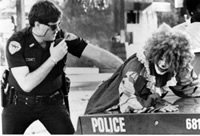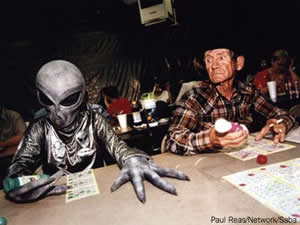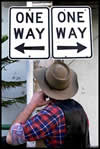

Unit
3 - Character
Module
2: The Written Word
Lesson
2 - Writing Your Own Monologue
Introduction:
The purpose of this activity is helping students understand
how monologue are constructed through the experience of the
construction process.
Objectives:
- to express ideas and emotions appropriate to specific characters
- to demonstrate ability to script a short scene or play
- to purposefully use the elements of focus, tension, contrast
and symbol in all of their dramatic work
Resources:
Music, photographs, newspaper articles
CELs:
C, CCT, IL
Components:
Critical/Responsive, Creative/Productive
| Note:
Students need to write lots of ideas, and keep them in a
journal. They also need to to learn to revise. Encourage
them to observe people closely and take notes whenever possible.
Keep a notebook handy at all times for thoughts that occur
at random. |
Activities:
Activity
1 - Warm Up Games
"Idea Association" - Have the students sit or stand
in a circle and select a word at random from the dictionary. Students
should say the first idea (or phrase) that comes to mind. Keep
associating ideas and connecting them in different ways. (3 min.)
"Story
Circle" - everyone has to add on to the story. The first
person holds a ball of wool and starts with a simple idea for
a story. Try to talk in images and feelings so the story comes
alive. Talk in the first person so that whoever is speaking is
also the hero of the story. When the person is done speaking they
must toss the ball of wool to another person in the circle, while
holding onto the wool string. Eventually, when the story is done
you will have created a spider web. Hang on to the wool and try
to untangle the group into one straight line. Do it without speaking,
and without letting go of the string. (10 min.)
Activity 2 - Ideas Inspiration:
Have
the students use any of the following "idea jump starters"
as a way into the work. Students should write a monologue in their
journals based on any one of these. (15 min.)
- remember
your first romance you thought you'd never get over
- look
through old photo's, diaries, toys, letters - anything to
trigger a memory
- stream
of consciousness, timed writing
- write
to a specific theme, i.e.; guilt, pride, obsession, fear,
etc.
- think
of a specific location, or time period
- write
to music
- write
without editing yourself - first thoughts
- change
your point of view - perspective of a dog, a bird, a teapot,
God
- imagine
life through the eyes of a real person, in a fictional event
- telephone
conversation
- a reporter
on the scene
- a speech
- or preparing to give a speech
- stand
up comedy routine
- imagine
the "real" story behind a news article, or tabloid
headline
- turn
at random to a page in the dictionary, point to a word and
use it it as your first word in the monologue
- write
about a painful memory - these often have emotional triggers
Activity
3 - Pare it Down
 |
Spalding
Gray says there is a story in each of us. Tell a story to
someone in 10 minutes. Then tell it in 5 minutes. Clarity
is important. Don't bore us with unnecessary details or
back story. Descriptive and specific images are one of the
main things which capture an audience's imagination. Your
feelings about the thing described is also very important.
(15 min.) |
Activity
4- What is the Story?
Look
at one of the images below to find the monologue. Have students
write the second monologue in their journals. (15 min.)
 |
Where
is this taking place?
Who
is in the clown suit? What did he/she do? What is he/she
thinking?
What
is the police officer thinking?
What
is the child thinking/feeling who is perhaps watching
the event?
|
|
Why
is the nun so happy at the computer?
What
is she doing?
How
long has she been a nun? How does she feel about her calling?
What
is her dream in life?
Who
was she before she became a nun?
|
|
 |
How
will they explain this mistake to the foreman?
What
happens next?
How
is this both funny and sad at the same time?
|
|
This
person is on a trip. Where and why?
He
later recounts his experience in a hostel that night.
How did the signs make him feel about his life? What is
the philosophical statement implied?
|
|
 |
Whose
point of view to write from? The alien or his bingo partner?
What
happens after this photo is taken?
What
is the man in the hat thinking?
|
|
What
must it be like to be them?
Write
three different monologues - one to show what each is
thinking at the time of the photo.
What
happens before - or immediately after the photo is taken?
|
|
 |
Put
yourself inside a famous painting. Look through the eyes
of another.
Write
from within a dream.
Put
it to music.
|
Activity
5 - Time to Share:
Students
find a partner, and take turns reading aloud one piece they have
written. The students should provide feedback for one another,
including suggestions for clarity. They should also give general
impressions of the character the monologue brings to mind. Finally,
they should brainstorm ways to revise the piece. (20 min.)
Instructional
Strategies:
Guides
for writing, Reflective study
Evaluation:
Informal
peer-evaluation is a part of the formative process.
On-line
Activity Alternatives:
Share
the work through e-mail in the class. Omit the warm-up.
Next
Lesson / Student Lesson
/Previous Lesson















